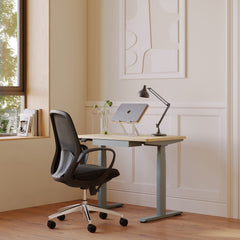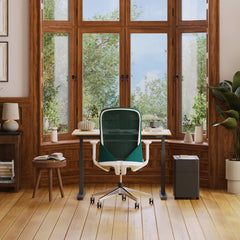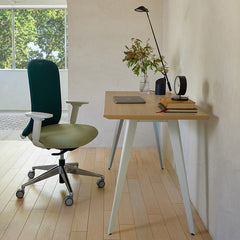Get 10% off your first order
Find the office furniture that’s designed to match your style, comfort, and needs perfectly. Subscribe
Space Shift: The Art of the Live-Work Fusion

Visit quiz page to see how we makes it easy to create an inspiring workplace


Seated posture is shaped by the natural S-curve of the spine, where the lumbar region gently arches inward and the thoracic region extends outward. The height and contour of a chair’s backrest directly influence this alignment. Low-back chairs typically support only the lower lumbar area, encouraging subtle engagement of the core muscles and promoting upright posture during shorter tasks. When sitting for under an hour, this active engagement can improve circulation and minimize stiffness without overly restricting movement.
Studies from CDC ergonomic insights emphasize the importance of dynamic postures in minimizing musculoskeletal strain. Their findings show that alternating postures and avoiding static sitting positions can reduce fatigue and lower back discomfort.
Different backrest heights serve different durations and body support needs. Low-back designs offer agility for brief sessions, while mid-back and high-back models deliver progressively deeper support. Understanding these distinctions helps users select the right chair for specific work patterns.
| Chair Type | Spinal Coverage | Ideal Session Length | Core Support Level |
|---|---|---|---|
| Low-Back | Lumbar only | 15–60 minutes | Light, promotes mobility |
| Mid-Back | Lumbar and mid-thoracic | 1–4 hours | Moderate, balanced support |
| High-Back | Full spine and neck | 4+ hours | High, continuous comfort |
Low-back chairs promote subtle muscle activation by allowing a small range of motion at the hips and waist. This supports natural micro-movements, reducing the risk of stiffness or pressure points. Short sitting sessions in low-back designs are particularly effective in creative environments where flexibility and focus shift quickly between tasks.
The appeal of a low-profile silhouette extends beyond function. Compact seating helps open up smaller rooms, making them feel more inviting and less cluttered. The aesthetic ergonomics in agile studios exemplifies how design-forward seating can blend comfort and minimalism, fostering a workspace that feels balanced, open, and purposeful.
Shorter sessions often emphasize mobility and alertness over deep relaxation. Low-back chairs are ideal for focused bursts of activity, meetings, and collaborative discussions. Their minimal structure prevents slouching and keeps the body lightly engaged.
After approximately one hour of static sitting, the spine begins to compress slightly, and the lumbar muscles fatigue without full support. Over time, this can lead to discomfort or strain in the lower back if movement breaks are not integrated.
| Chair Type | Ideal Session Length | Primary Advantage | Potential Limitation |
|---|---|---|---|
| Low-Back | 15–60 minutes | Enhances movement and posture awareness | Limited upper back support |
| Mid-Back | 1–4 hours | Balanced comfort with lumbar engagement | May lack neck support |
| High-Back | 4+ hours | Complete spinal coverage | Restricts shoulder flexibility |
For those alternating between quick sessions and moderate-duration work, the mid-back office chair with balanced lumbar support offers a versatile option that combines flexibility and comfort.
When the backrest ends below the shoulder blades, the body instinctively stabilizes itself using the core and pelvic muscles. This engagement helps maintain posture while preventing overreliance on external support. For short-term work sessions, this kind of active sitting can improve postural awareness and energy levels.
Environments built for teamwork or idea generation benefit from lighter, mobile seating. The modern task chair for agile teams demonstrates how ergonomic design can support fluid collaboration and posture changes throughout the day.
Proper alignment between desk and seat height prevents slumped shoulders and neck strain. When paired with the correct desk, a low-back chair allows the elbows to rest at 90 degrees and the monitor to remain at eye level, keeping posture neutral and comfortable.
Alternating between sitting and standing encourages blood flow and helps maintain alertness. The height-adjustable Mini Standing Desk offers a practical way to integrate movement into the workday, reducing prolonged static postures.
1. Align the monitor top with eye level.
2. Keep elbows at a right angle and wrists straight.
3. Position feet flat with hips slightly above knee height.
4. Alternate positions at least every hour to maintain circulation.
Compact seating now doubles as a design element, merging ergonomics with interior aesthetics. Low-back chairs add modern style without overwhelming visual space, making them ideal for collaborative offices and lounge areas.
The Seashell Chair exemplifies how thoughtful form and soft curvature deliver ergonomic comfort without bulk. Its shell-inspired design supports short sitting periods while maintaining a refined, modern look.
Low-back furniture helps businesses maximize square footage. These designs offer comfort for short interactions while maintaining open sightlines and an uncluttered atmosphere—ideal for shared work environments and compact studios.
Matching a chair to a user’s task type and duration ensures both productivity and physical comfort. Each design has its optimal purpose, from creative collaboration to deep-focus work.
| Work Style | Recommended Chair Type | Average Duration | Main Benefit |
|---|---|---|---|
| Brainstorming sessions | Low-back | 30–60 minutes | Encourages movement and alertness |
| Focused desk work | Mid-back | 2–4 hours | Balanced lumbar and mid-spine support |
| Intensive research | High-back | 4+ hours | Sustained posture and upper-body comfort |
For users exploring options that complement varied work rhythms, Urbanica’s diverse chair collection for every workspace provides models designed for both agility and ergonomic reliability.
A flexible ergonomic setup accommodates different tasks throughout the day. By mixing seating types with adjustable desks, users can support movement while maintaining consistent alignment.
Urbanica’s Build Your Bundle tool for tailored setups allows individuals to curate furniture combinations that fit both function and design preferences. This modular approach supports changing work styles and evolving office needs.
Furniture design is increasingly focusing on balance, adaptability, and wellness. Low-back seating will continue to play a role in promoting motion-based ergonomics, supporting workplaces that value comfort, health, and creativity.
Workplace design is evolving to encourage frequent posture changes, walking breaks, and active engagement. Low-back chairs naturally complement this shift by enabling fluid transitions between sitting, standing, and collaborating.
Future office environments are expected to merge ergonomics with overall well-being, emphasizing natural light, movement, and mindfulness. Low-back seating fits within this philosophy, promoting awareness and movement during shorter, intentional work sessions.
Low-back chairs, when thoughtfully selected and paired with the right workstation elements, deliver both comfort and versatility for short-duration tasks. Their simplicity supports motion, encourages healthy posture, and enhances the modern workspace’s openness and adaptability.

Space Shift: The Art of the Live-Work Fusion

How to Arrange Furniture to Maximize Peace

Crafting Calm: Your Guide to the Perfect Reading Corner
Get 10% off your first order
Find the office furniture that’s designed to match your style, comfort, and needs perfectly. Subscribe
Leave a comment